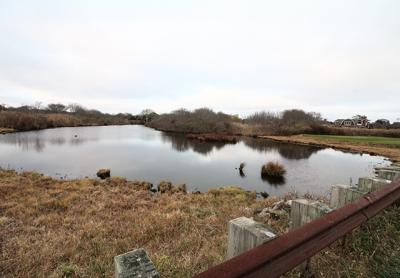Maidstone Bridge Proposal Draws Flak

The Maidstone Club’s plan to build a 352-foot-long wooden bridge across the inland section of Hook Pond known as the Hook Pond Dreen has drawn increasing opposition since the East Hampton Village Zoning Board of Appeals first reviewed the proposal in October.
Two East Hampton Ladies Village Improvement Society committees have spoken out against the bridge, and it drew scrutiny from the East Hampton Town Trustees, who at a meeting on Monday expressed concern about its environmental impact as well as skepticism about its necessity.
The private club’s officials argue that the bridge, which would connect the second tee with its fairway, is essential to safety because golfers and golf carts now share an existing stone bridge on Dunemere Lane with motorists, cyclists, and pedestrians. The L.V.I.S. landmarks and nature trail committees, as well as environmental activists and others, have cited its potential negative impact on wildlife habitats and the area’s scenic vista.
The club is seeking variances from the East Hampton Village Zoning Board of Appeals. The State Environmental Conservation has already determined the construction would not require a study under the State Environmental Quality Review Act. The proposal also requires Design Review Board review.
The Z.B.A. has discussed the proposal at two meetings, with its formal public hearing scheduled to continue on Friday, Dec. 9. At issue are variances from required setbacks from residential property and a village-owned reserve, as well as a freshwater wetlands permit.
On Monday, Richard Whalen, the trustees’ attorney, discussed the matter of trustee ownership. The trustees own the bottomlands of most waterways in town on behalf of the public and clearly own the major part of Hook Pond. But Mr. Whalen referred to maps and deeds from the 19th and 20th centuries, which purportedly show the club acquired the land on the north side of Dunemere Lane, where the bridge is to be constructed, via a 1915 deed. Mr. Whalen suggested the trustees may nevertheless have a claim to the bottomland, where the club would install 42 footings for the bridge, which would be 140 feet north of Dunemere Lane.
“Maidstone is claiming they own to the centerline of the pond,” he said. “The 1915 deed would support that. What I want to know is . . . did the land title run to the water, or to the centerline?”
Regardless of ownership, the trustees decided on Monday that as adjacent property owners they should issue an opinion on the proposed bridge, whose use would be exclusive to golfers, golf carts, and vehicles used by the club’s maintenance crew. The club would have to apply to the trustees for approval were they to claim actual ownership.
Jim Grimes, a trustee, noting that the project would result in further fragmentation of the wetlands system and disruption to its wildlife, said, “We are downstream adjacent property owners. Anything that goes on here directly impacts us.” The club, he said, should reconsider the bridge’s location and ensure a minimal environmental impact from any construction.
Tyler Armstrong, another member of the panel, said the 42 pilings would create “a lot of disturbance to the waterway” and collect sediment in a water body that has no tidal flushing and little flow. Introducing structures “will cause increased sedimentation problems. A private infrastructure that could affect public land — I’m not in favor of it,” he said.
The trustees’ clerk, or presiding officer, Francis Bock, also spoke against the bridge. “I see this area all the time. I see wildlife activity, I’d hate to see it disrupted,” he said.
Mr. Whalen was to draft a letter detailing the trustees’ concerns, which is to be forwarded to the zoning board.
Also at the meeting, the trustees heard from Kevin McAllister, the former Peconic Baykeeper and founder of the environmental advocacy organization Defend H2O. On Nov. 14, he had asked the trustees to reiterate their opposition to the aerial application of methoprene, a mosquito larvicide, by Suffolk County. The Suffolk Legislature is finalizing its 2017 schedules, and the county’s Council on Environmental Quality voted on Oct. 19 to include the use of methoprene to control mosquitoes, a vector for the West Nile virus and other diseases, again this year.
Mr. McAllister addressed the Legislature’s Public Works, Transportation, and Energy Committee on Monday, he told the trustees, to warn of the hazard he said methoprene poses to nontarget species, including lobsters and crabs. At the recommendation of Legislator Bridget Fleming, a former Southampton Town Councilwoman who represents the South Fork, as well as Shelter Island and part of Brookhaven, the Legislature tabled the discussion.
“To Legislator Fleming’s credit, she convinced her colleagues to table this for two weeks,” Mr. McAllister said. “She knows public sentiment within her district.” The committee will reconsider the 2017 plan on Dec. 12, with the Legislature scheduled to vote on Dec. 20.
“One of the things I’ve tried to do since I was sworn in is to try to get a better communication between local officials and county officials,” Ms. Fleming said yesterday. “The trustees are obviously front and center when it comes to water quality. At the very least, they need to get a full hearing before that plan is adopted. I feel there is a lot of room between continuing what the program has been for many years, and something else that will still address the problem of mosquitoes.”
Mr. McAllister reminded the trustees that methoprene has been prohibited in Connecticut’s coastal areas since 2013, except in the event of a declared health emergency — “And the sky is not falling,” he said. The county’s Public Works Department, he said, is motivated more by nuisance control than a threat to public health. “As a semi-rural region on the East End, where we prioritize our fisheries, our water lifestyle, this has no place here,” he said. “Collectively, if we come together and bring some pressure to bear, hopefully we could persuade the Legislature to excise methoprene.”
